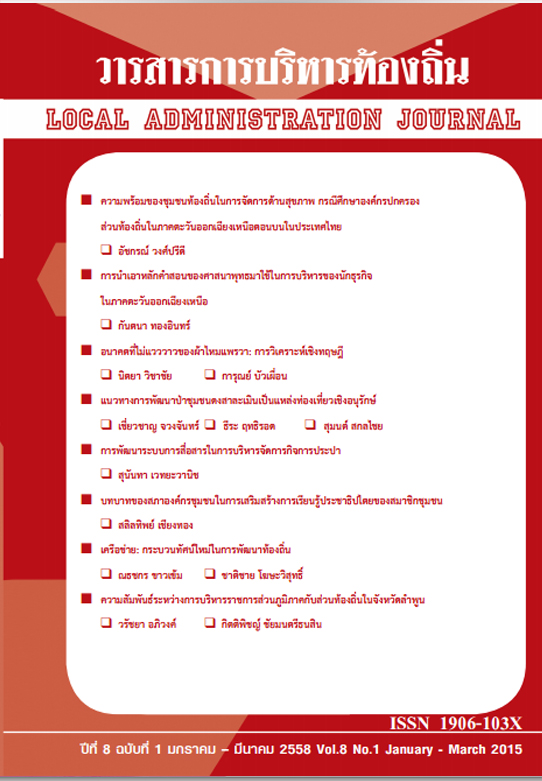อนาคตที่ไม่แวววาวของผ้าไหมแพรวา: การวิเคราะห์เชิงทฤษฎี
Keywords:
กลุ่มทอผ้าไหมแพรวา, การอนุรักษ์การทอผ้าไหมแพรวา, Praewa silk Weaving Group, Maintenance of Praewa Silk WeavingAbstract
ในรายงานวิจัยฉบับนี้ได้วิเคราะห์ถึงแนวโน้มการคงอยู่และยั่งยืนของผ้าไหมแพรวาในอนาคตโดยใช้แนวคิดและทฤษฎีทางการตลาด 7 แนวคิดทฤษฎีมาประยุกต์ อันได้แก่ 1) กรอบแนวคิดที่อิงทฤษฎี 5 พลังในการแข่งขัน 2) กรอบแนวคิดของการวิเคราะห์การเมือง เศรษฐกิจ สังคมและเทคโนโลยี 3) กรอบแนวคิดในการวิเคราะห์ธุรกิจแบบมุ่งเป้าหมายเฉพาะบางส่วน 4) กรอบแนวคิดในการวิเคราะห์ความได้เปรียบทางการแข่งขัน 5) กรอบแนวคิดในการวิเคราะห์วงจรชีวิตของสินค้า 6) กรอบแนวคิดในการวิเคราะห์ทิศทางและแนวโน้มของสินค้าหรือผลิตภัณฑ์ที่จะเกิดขึ้นใหม่ในอนาคต และ 7) กรอบแนวคิดว่าด้วยเรื่องปัจจัย 5 ปัจจัยที่ส่งเสริมการตลาดผู้วิจัยได้เก็บรวบรวมข้อมูลโดยวิธีการสัมภาษณ์แบบเจาะลึกจากผู้ให้ข้อมูลหลัก (Key Informant) จำนวน 18 คน จำแนกออกเป็น 3 กลุ่ม ได้แก่ กลุ่มผู้ประกอบการทอผ้าไหมแพรวา จำนวน 10 คน ผู้ประกอบการขายผ้าไหมแพรวา 5 คน และเจ้าหน้าที่ของรัฐที่มีหน้าที่ส่งเสริมการทอผ้าไหมแพรวา 3 คน
ผลการวิจัยครั้งนี้ได้ข้อสรุปว่า มีปัจจัยต่าง ๆ หลายปัจจัยที่จะมีผลทำให้จำนวนผู้ทอผ้าไหมแพรวาลดลง จนอาจจะถึงจุดที่เกิดการสูญเสียมรดกทางวัฒนธรรมอันมีคุณค่ายิ่งของชาวผู้ไทในงานวิจัยนี้ได้ให้ข้อเสนอแนะให้องค์กรปกครองส่วนท้องถิ่นในพื้นที่อำเภอคำม่วงได้กำหนดนโยบายและจัดสรรงบประมาณสนับสนุนเพื่อฟื้นฟู อนุรักษ์ และส่งเสริมการทอผ้าไหมแพรวาให้สามารถคงอยู่ได้
The Not So Bright Future of Praewa1 Silk: A Theoretical Analysis
This report analyzes the future prospects of Praewa silk. The specific questions addressed in the research upon which this paper was based is whether Praewa silk can maintain itself and whether it is a viable economic option for the local people to continue to weave it. In the analyses of the possible scenarios, seven well-known conceptual frameworks in the field of marketing were applied: 1) Porter’s five forces model; 2) Political, Economical, Social and Technological Analysis, commonly known as PEST Analysis; 3) Market Segmentation Analysis; 4) Competitive Advantage Model; 5) Product Life Cycle Analysis and Assessment; 6) the threat from the entry of new product; and 7) the Five P’s of Marketing.
The data for this research were collected by in-depth interviews with 18 key informants; 10 Praewa silk weavers, 5 owners of Praewa silk shops, and 3 government officials who were in charge of Praewa silk promotion.
Results from these analyses indicated clearly that most factors were operating against the future prospects of Praewa silk. Already, we have seen a dwindling number of Praewa silk weavers in Kham Muang district, which is the only district in Thailand that produces it. In the future, it is likely that there will be nobody left who still has an interest in producing this type of silk. When that happens, it would be a colossal cultural loss for the Thai culture and for the country. It is recommended in this study that all local governments in Kham Muang district formulate a clear policy and demonstrate their strong commitment to cultural preservation by allocating enough budgets to revitalize, maintain, and promote the cultural practice of Praewa silk weaving among the residents in the area.
Downloads
Published
How to Cite
Issue
Section
License
The copyright of all articles published in the Local Administration Journalis owned by the College of Local Administration, Khon Kaen University.



